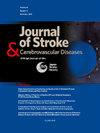Melatonin attenuates brain edema via the PI3K/Akt/Nrf2 pathway in rats with cerebral ischemia-reperfusion injury
IF 2
4区 医学
Q3 NEUROSCIENCES
Journal of Stroke & Cerebrovascular Diseases
Pub Date : 2025-03-28
DOI:10.1016/j.jstrokecerebrovasdis.2025.108299
引用次数: 0
Abstract
Objective
This study aimed to explore the neuroprotective effects of Melatonin (Mel) administration on cerebral ischemia-reperfusion injury (CIRI) and elucidate its underlying mechanism in vivo to provide a theoretical foundation for the clinical application of Mel.
Materials and methods
CIRI models were established in male adult Sprague Dawley rats by middle cerebral artery occlusion (MCAO) for 2 h. Water content of brain tissue was assessed using both dry/wet weight method and T2-weighted Imaging (T2WI). The infarct volume of the brain was measured by 2,3,5-triphenyltetrazolium chloride (TTC) staining. Cell morphology changes and brain damage were detected through hematoxylin & eosin (H&E) staining and NeuN immunofluorescence staining. The integrity of blood-brain barrier (BBB) was examined using transmission electron microscopy (TEM). The expression of aquaporin 4 (AQP4) protein was quantified through western blots analysis and immunofluorescence staining. The expression of p-PI3K, p-AKT and Nrf2 proteins were detected by immunohistochemistry staining and western blots analysis.
Results
Compared with the CIRI group, Mel administration significantly reduced the infarct volume and ameliorated the morphology alterations, accompanied by an increase in the number of neurons. The water content of brain tissue decreased significantly, and the value of relative average diffusion coefficient (rADC) of injured brain increased in the CIRI + Mel group as compared with the CIRI group. Compared with the CIRI group, Mel administration improved the damage to the tight junctions of endothelial cells in the cerebral cortex. The expression of AQP4 protein decreased, and that of p-PI3K, p-AKT and Nrf2 proteins increased in the CIRI + Mel group compared with the CIRI group. After administration of p-PI3K inhibitor LY294002, the expression of AQP4 was upregulated, and that of the p-PI3K, p-AKT and Nrf2 proteins decreased compared with the CIRI + Mel group.
Conclusions
Mel administration exerts neuroprotective effects against CIRI by mitigating brain edema through upregulating the PI3K/AKT/Nrf2 signaling pathway, and then attenuating brain damage in CIRI rats.
褪黑素通过PI3K/Akt/Nrf2途径减轻脑缺血再灌注损伤大鼠的脑水肿
目的:本研究旨在探讨褪黑素(Melatonin, Mel)对脑缺血再灌注损伤(cerebral缺血-再灌注损伤,CIRI)的神经保护作用,并阐明其体内机制,为Mel的临床应用提供理论基础。材料与方法:采用雄性成年大鼠大脑中动脉闭塞(MCAO) 2小时,建立成年雄性大鼠CIRI模型。采用干/湿重法和t2加权成像(T2WI)评估脑组织含水量。采用2,3,5-三苯基四氮唑(TTC)染色法测定脑梗死体积。通过苏木精伊红(H&E)染色和NeuN免疫荧光染色检测细胞形态变化和脑损伤情况。透射电镜(TEM)检查血脑屏障(BBB)的完整性。western blots法和免疫荧光染色法定量测定水通道蛋白4 (AQP4)的表达。免疫组化染色和western blot检测p-PI3K、p-AKT和Nrf2的表达。结果:与CIRI组比较,Mel可显著降低梗死面积,改善梗死后形态学改变,并伴有神经元数量增加。与CIRI组相比,CIRI + Mel组脑组织含水量明显降低,损伤脑相对平均扩散系数(rADC)值升高。与CIRI组相比,Mel可改善大脑皮质内皮细胞紧密连接损伤。与CIRI组相比,CIRI + Mel组AQP4蛋白表达降低,p-PI3K、p-AKT和Nrf2蛋白表达升高。与CIRI + Mel组相比,给予p-PI3K抑制剂LY294002后,AQP4表达上调,p-PI3K、p-AKT和Nrf2蛋白表达降低。结论:Mel通过上调PI3K/AKT/Nrf2信号通路,减轻脑水肿,减轻CIRI大鼠脑损伤,对CIRI具有神经保护作用。
本文章由计算机程序翻译,如有差异,请以英文原文为准。
求助全文
约1分钟内获得全文
求助全文
来源期刊

Journal of Stroke & Cerebrovascular Diseases
Medicine-Surgery
CiteScore
5.00
自引率
4.00%
发文量
583
审稿时长
62 days
期刊介绍:
The Journal of Stroke & Cerebrovascular Diseases publishes original papers on basic and clinical science related to the fields of stroke and cerebrovascular diseases. The Journal also features review articles, controversies, methods and technical notes, selected case reports and other original articles of special nature. Its editorial mission is to focus on prevention and repair of cerebrovascular disease. Clinical papers emphasize medical and surgical aspects of stroke, clinical trials and design, epidemiology, stroke care delivery systems and outcomes, imaging sciences and rehabilitation of stroke. The Journal will be of special interest to specialists involved in caring for patients with cerebrovascular disease, including neurologists, neurosurgeons and cardiologists.
 求助内容:
求助内容: 应助结果提醒方式:
应助结果提醒方式:


